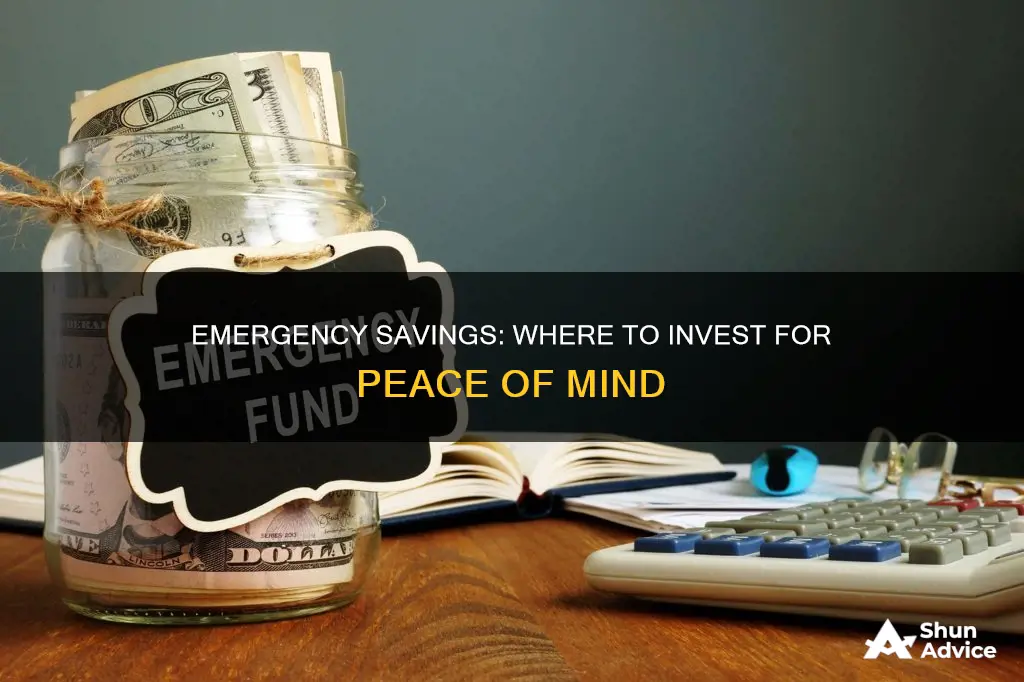
Emergency funds are essential to help you stay afloat during financial emergencies, such as unexpected medical bills, home repairs, or job loss. While it's generally recommended to keep your emergency savings in a safe, low-risk, and highly liquid account, you may want to explore investing options to beat inflation and potentially grow your savings. This decision depends on your risk tolerance and financial situation. Here are some factors to consider when deciding where to invest your emergency fund.
Firstly, assess your risk tolerance and financial circumstances. If you have a low-risk tolerance or are just starting to build your emergency fund, a traditional savings account or money market account may be the best option. These accounts offer safety and liquidity, ensuring your money is easily accessible when needed. On the other hand, if you have a higher risk tolerance and a substantial emergency fund already saved, investing in a well-diversified portfolio might be a suitable choice.
Secondly, consider the potential trade-off between liquidity and investment returns. While keeping your emergency fund in a savings account provides immediate access to your money, investing in assets like stocks or real estate may offer higher returns but with reduced liquidity. Before investing in less liquid assets, ensure you have enough easily accessible funds to cover short-term emergencies.
Lastly, evaluate the potential risks and volatility of different investment options. Stocks, for example, are generally considered more volatile and may force you to sell at a loss during an emergency. In contrast, money market accounts, high-yield savings accounts, and certificates of deposit (CDs) offer lower returns but are considered safer options.
Remember, the primary purpose of an emergency fund is to provide financial security and accessibility during unexpected events. Carefully weigh your options, understand the risks involved, and make a decision that aligns with your financial goals and comfort level.
| Characteristics | Values |
|---|---|
| Accessibility | Quick and easy access |
| Liquidity | High liquidity |
| Risk | Low risk |
| Returns | Interest |
| Safety | FDIC-insured |
What You'll Learn

High-yield savings accounts
Popular Direct: 4.85% APY
Popular Direct Savings offers one of the highest APYs at 4.85%. You must deposit at least $100 when you open the account, but there are no monthly service fees. This account also provides easy access through mobile and online banking. Popular Direct is a division of Popular Bank.
CIT Bank Platinum Savings: 4.85% APY
If you have significant savings, CIT Bank's Platinum Savings account is worth considering. It offers 4.85% APY but you must deposit at least $100 upon account opening and maintain a balance of at least $5,000 (if you don't meet the minimum balance, you'll only earn 0.25% APY). This account has no ongoing fees. CIT Bank is a division of First-Citizens Bank and Trust.
UFB Direct: 4.81% APY
UFB Direct's Premier Savings account is great for those who value an easy, hassle-free banking experience in addition to high yields. In addition to a competitive 4.81% APY, it has no account minimums or fees. It also provides a free ATM card, mobile check deposit and other online bank features. UFB Direct is a division of Axos Bank.
TAB Bank: 4.76% APY
TAB Bank's high-yield savings account earns 4.76% APY and has no minimum balance or deposit requirement and no maintenance fees. It also has no maximum balance requirement, which means there's no cap on how much interest you can earn.
Bask Bank: 4.75% APY
Bask Bank's Interest Savings account has an APY of 4.75%. There are no monthly fees or minimum balance requirements, but you do need to deposit something within 15 days of opening your account. Bask Bank is a division of Texas Capital Bank.
Salem Five Direct: 4.61% APY
You'll earn 4.61% APY with the eOne Savings account from Salem Five Direct. You'll need to deposit at least $10 to open the account, but you'll earn interest on deposits up to $1 million. The account also has no monthly fees or minimum balance requirements. Salem Five Direct is a division of Salem Five Bank.
Bread Savings: 4.61% APY
Bread Savings' high-yield savings account earns a healthy 4.65% APY and has no monthly or maintenance fees. You must deposit a minimum of $100 to open the account. Bread Savings is a part of Bread Financial, formerly known as Comenity Capital Bank.
Citizens Access: 4.50% APY
If you have more than $0.01, you can open a High-Yield Online Savings account with Citizens Access. That's their minimum opening deposit requirement. The account offers 4.50% APY, as well as no monthly fees.
From Saving to Investing: Strategies for Your Financial Journey
You may want to see also

Money market accounts
When choosing a money market account, shop around and compare fees and features to select the best option for your emergency savings.
529 Savings Plans: Smart Investment Strategies, per Forbes
You may want to see also

CDs (certificates of deposit)
Certificates of deposit (CDs) are a type of savings account that pays a fixed interest rate on money held for an agreed-upon period of time. They are considered a safe and conservative investment option, offering lower risk and volatility than stocks and bonds. CDs are insured by the Federal Deposit Insurance Corporation (FDIC) or the National Credit Union Administration (NCUA), which means your money is protected up to $250,000 per account.
One of the benefits of investing in CDs is that they typically offer higher interest rates than regular savings accounts. The longer the maturity term, the higher the interest rate. For example, a five-year CD will have a higher interest rate than a one-year CD. However, it's important to note that you usually have to pay a penalty if you withdraw your funds before the maturity date. This is known as an early withdrawal penalty (EWP) and can be charged as a flat fee or a percentage of the interest earned.
CDs are a good option if you want to save for a specific financial goal, such as a vacation, a new home, or a car. They can also be useful for emergency funds if you are sure you won't need to access the money right away. CDs offer predictability, as it is relatively easy to determine how much interest you'll earn, and they don't usually charge monthly maintenance fees.
To get the best CD rates, it's recommended to shop around at different banks and credit unions. Consider factors such as interest rates, maturity terms, minimum deposit requirements, and early withdrawal penalties when choosing a CD account.
Overall, CDs can be a great way to grow your savings over time while minimising risk. However, it's important to keep in mind that your money will be locked into the investment for the specified term, and early withdrawals may come with penalties.
Invest Wisely to Secure Your Dream Home
You may want to see also

Credit cards
Advantages of Using Credit Cards for Emergencies:
- You can earn rewards while dealing with unexpected expenses. For example, a cashback credit card can give back a percentage of your spending, providing some relief.
- In a true emergency, a credit card can help you get the care and assistance you need when you need it.
- If you have a large, unexpected bill, a credit card can help you pay for it without having to immediately dip into your savings.
Disadvantages of Using Credit Cards for Emergencies:
- You could hurt your credit score by raising your credit utilization ratio, which measures your debt against the amount of credit available.
- Credit card debt can be expensive. If you don't have a plan to pay the money back, you could end up paying high-interest rates and wind up in debt.
- Credit card issuers don't like cards sitting unused for extended periods, so your emergency card could get canceled or have its credit limit lowered.
- If you max out a credit card, you can expect your credit score to drop substantially due to the increase in your credit utilization ratio.
Tips for Using Credit Cards for Emergencies:
- Use your credit card's available credit together with emergency funds to pay for emergency expenses.
- Look for no-annual-fee credit cards and rewards cards that offer incentives such as cashback or perks.
- Consider a personal loan or a charge card as alternatives to a credit card. A personal loan can save you from paying high-interest rates, and a charge card must be paid in full each month but doesn't charge interest.
- Avoid carrying a credit card balance. If you're already in debt when an emergency arises, using a credit card will only increase your debt.
- Start an emergency savings fund, even if you can only contribute a small amount each week. This will help you avoid relying solely on credit cards in an emergency.
- If you must rely on a credit card, consider getting a new card with a 0% introductory APR on purchases to save on interest.
Strategies for Investing While Saving for a Home
You may want to see also

Stocks
While it is generally not recommended to invest emergency funds in stocks, some people do choose to put a portion of their emergency savings into stocks to try to earn money. However, it is important to keep in mind that stocks are fairly volatile, so you may be forced to sell at a loss if you face an emergency expense. Additionally, selling stocks can take several days, so you won't have immediate access to the cash.
If you are considering investing your emergency fund in stocks, it is important to have a significant amount of savings already built up. It is also recommended that you have high-limit credit cards, multiple streams of income, and good health insurance. This will help ensure that you have other resources to cover emergency expenses if your stock investments lose value.
To mitigate the risk of losing money in the stock market, you can overfund your emergency account. This means estimating the maximum degree by which your account could drop in value and then adding that amount to your emergency fund. For example, if you estimate that your account could lose 10% of its value, you would add an extra 10% to your emergency fund.
When investing your emergency fund in stocks, it is important to diversify your portfolio and choose relatively low-risk investments. Index funds, treasury bonds, and short-term bonds are generally considered safer options. You can also use a combination of stocks and bonds to reduce risk, such as a portfolio with 10% stocks and 90% short-term treasury bonds.
Remember that investing your emergency fund in stocks carries a higher risk than traditional savings accounts or money market accounts. Make sure to carefully consider your financial situation, risk tolerance, and other resources before deciding to invest your emergency fund in stocks.
Kroger Savings Club: A Smart Investment Strategy
You may want to see also
Frequently asked questions
It is recommended to keep your emergency fund in a savings account or money market fund. This ensures that your money is easily accessible and safe from market volatility. While you may earn a higher return by investing in the stock market, there is a risk of losing your initial investment if the market declines.
It is generally recommended to keep enough money in your emergency fund to cover three to six months' worth of living expenses. This will help you prepare for both spending shocks (e.g. unexpected repairs or medical bills) and income shocks (e.g. job loss).
Yes, there are a few alternatives to consider. Money market accounts, high-yield savings accounts, and Certificates of Deposit (CDs) can provide higher interest rates while still keeping your funds relatively liquid and easily accessible.







